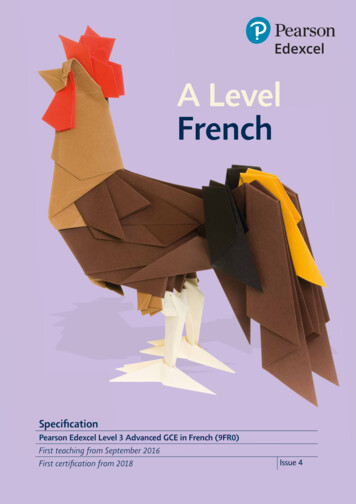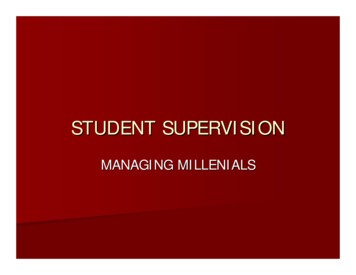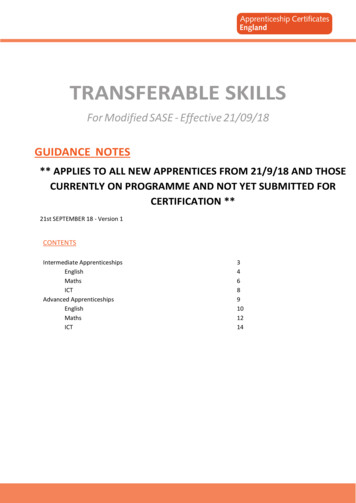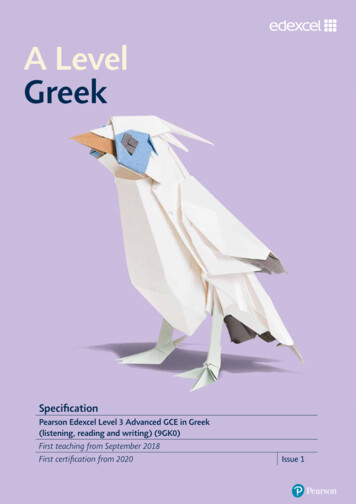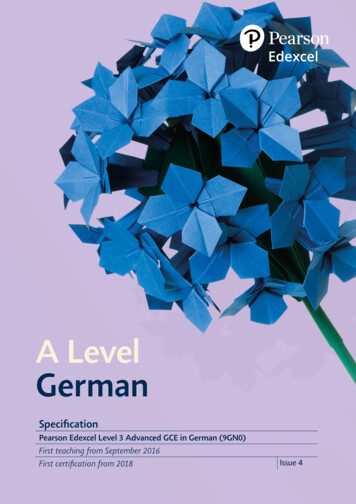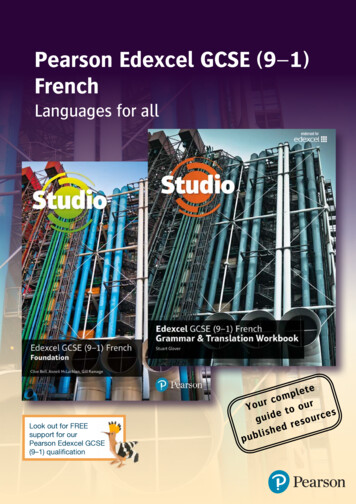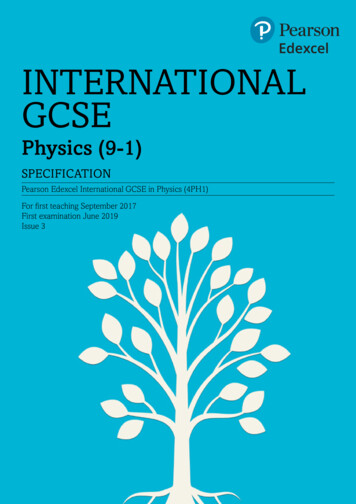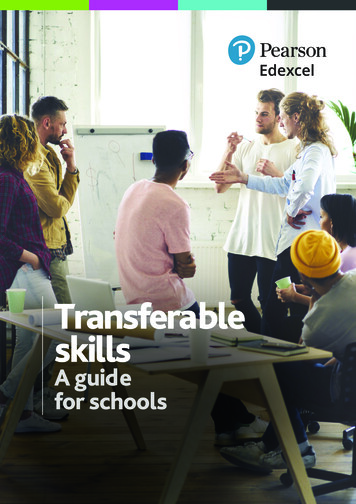
Transcription
TransferableskillsA guidefor schools
The global transferable skills gapIn recent years, universities and employers have highlighted the needfor students and graduates to develop a range of transferable skills,often referred to as ‘soft skills’, to enable them to better meet thedemands of undergraduate study and the world of work.In fact, universities and employers consider transferable skillsto be the largest skills gap overall.1 in 654%1 in 387%employershave difficultyfindingcandidateswith the skillsthey require1of companiessay that skillsshortages impacttheir abilityto serve theircustomers2skills in ajob posting is a“soft skill”1of universityprofessorsdo not thinkstudents havethe researchskills needed fordegree-levelstudy3The transferable skills gap demonstratesthat students require more than just‘knowledge’ to be successful.It’s about skills as well as knowledgeto be successful at further study,higher education and in the workplace.1Employability - Personal & Social Capability Framework report from Pearson, 2016.2Employability report from PSB for Pearson, 2016.3Bridging the Gap: Understanding the Differing Research Expectations of First-Year Students and Professors, Meg Raven, Mount Saint Vincent University), 2016.
The global transferable skills gapIt’s really the more fundamental skillslike teamwork and communicationthat seem to matter the most,that employers demand the most”Guy Berger, the chief economist at LinkedIn.JOBVACANCY:ManagerKEY REQUIREMENTS:Mus t have excellent:Mus t be:Communication skillsFlexibleTeam working skillsAdaptableInterpersonal skillsSelf-motivatedAnalytical skillsProblem-solving skillsResearch we have conducted recently highlights that teachers,parents and students are aware of the global transferable skills gapand as a result, seek a truly comprehensive curriculum that developsnot only subject knowledge, but the transferable skills in demandby university and employers.This is why we have ensured that transferable skills areembedded in the new Pearson Edexcel International GCSEs (9–1)and Pearson Edexcel International Advanced Levels, as well as thenew iPrimary and iLowerSecondary for 5-14 year-olds.
What are transferable skills?The Organisation for Economic Co-operation and Development (OECD)defines transferable skills as ‘the bundle of knowledge, attributes andcapacities that can be learned and that enable individuals to successfullyand consistently perform an activity or task and can be built upon andextended through learning’.Education systems around the world also refer to transferable skills er orderthinking skills21st centuryskillsCreativity on’s research team reviewed a number of skills frameworks for ourEdexcel qualifications, and selected the US National Research Council’s(NRC) framework as being the most suitable. This is because: The NRC is the most evidence-based and robust of its type. The framework includes cognitive, intrapersonal and interpersonal skills. During the development process of our International GCSEs and InternationalAdvanced Level qualifications and resources, we have ensured that there areopportunities for the transferable skills contained in the NRC framework to bedeveloped and assessed, where a transferable skill naturally occurs within asubject (not all skills will be relevant for every subject). The breadth of transferable skills, listed in the NRC framework diagrambelow are covered by the full range of subjects in the Pearson EdexcelInternational GCSE (9–1) curriculum and Pearson Edexcel InternationalAdvanced Levels.65%of children aged 12in 2015 will do jobsthat don’t exist yet!11Future of Skills 2030 research by Pearson, Nesta and the Oxford Martin School: futureskills.pearson.com
NRC transferable skills frameworkCognitiveSkills“Core skills yourbrain uses to think,learn and reason –used to carry outany task”Intrapersonalskills“This is emotionalintelligence, theability to know,understand andmanage your ownemotionsand learning”Cognitive Processesand StrategiesCreativityCritical ThinkingCreativityProblem SolvingInnovationAnalysisReasoning / ArgumentationIntellectualOpennessWork Ethic /ConscientiousnessPositive CoreSelf sonal and esponsibilitySelf-reinforcementContinuous LearningIntellectual Interestand CuriosityPerseveranceProductivityAdaptive reflection)Executive FunctionEthicsInterpretationDecision MakingIntegrityTeamwork and CollaborationInterpersonalSkills“The life skills we useeveryday tocommunicateand interact withother people, bothindividuallyand in ationInterpersonal SkillsEmpathy / Perspective TakingNegotiationLeadershipResponsibilityAssertive CommunicationSelf-Presentation
FORAGES5-14Pearson Edexcel iPrimary andiLowerSecondary overviewPearson Edexcel iPrimary and iLowerSecondary are one-stop international programmes forchildren aged 5–14. It’s not just a curriculum – it’s a complete toolkit for schools.Keep your skills sharpwith free face-to-faceteacher training andonline ProfessionalDevelopment support.Cut your planningtime with our lessonand unit planexamples.Guide your students throughthe curriculum withour ready-made schemesof work.Easily work out exactlywhat to teach and whenwith our detailedteacher’s guides.Measure your students’learning with built-inProgress andAchievement Tests.Steer students towardssuccess at InternationalGCSE with a curriculum thatbuilds on their learning atevery stage.Draw your students inwith an internationally focusedcurriculum, written withadditional languagelearners in mind.Make sureknowledge stickswith accessible andculturally-relevant examplesand resources.
How are transferable skillscovered in Pearson EdexceliPrimary and iLowerSecondaryPrinciples for progress are a collection of the 10 principles (identified by our pedagogical experts)that will give your students the best opportunity to make progress in their learning. Each principleis accompanied by guidance relating to specific teaching approaches, tips and issues to watch outfor, all written in clear, practical steps that you can use in the classroom. Formative assessmentunderpins and runs through all of these principles. Knowing the students’ starting point,understanding their learning and reflecting on their development helps to ensure progress for all.PrincipleSummary1EngagingeveryoneHere you will find techniques for ensuring that all students are involved in the lesson andparticipate in discussion, including whole class question and answer sessions.2DifferentiationThis section provides techniques for adapting your teaching to ensure that all students canaccess the learning according to their level and achieve good outcomes. These techniquesalso convey the importance of having high expectations of all students.3EnablingindependentlearningThis section outlines suggestions for supporting your students to ‘have a go’ and not tobe put off by challenging ideas or tasks. It also has techniques for helping all students takemore responsibility for their own progress.4EffectivequestioningThis section offers practical tips for asking questions that make students think. It outlinesquestion types (for example, closed, open, factual, conceptual, probing, discussion) andprovides examples of each.5Teacher talkTeacher talk is important and this section outlines how to make it as effective as possiblewith ways of engaging your students as you introduce new content and explain activities.6CollaborativeactivitiesIn this section you will find lots of practical ideas for grouping students and ensuring thatgroup work is really focused and productive. It also outlines ways of developing studentownership of their learning and the ways in which group work can build confidence too.7TeacherdemonstrationThis section is focused on how to conduct effective teacher demonstrations and how youcan model important learning behaviours too.8Developingthinking skillsIn this section you will find good ideas for developing your students’ abilities to thinkcritically, to problem-solve and to carry out their own mini inquiries.9Reflecting onlearningHere, you will find ideas to encourage students to think constructively about their ownlearning and to take control over how to make better progress.Feedback (inboth directions)This section offers practical ideas for conducting good two-way feedback between you andyour students in order to improve learning and achievement.10
FORAGES14-16An overview of the new PearsonEdexcel International GCSEs (9–1)Our new suite of International GCSE (9–1) qualifications are designed to:Be more relevantfor internationalstudentsWith more internationalcontent, including theaddition of furtherinternational contenttopics and the use of localcontexts where possible.Provide detailedexam analysis withResultsPlusResultsPlus is a serviceunique to Pearson thatprovides free online indepth mock and actualexam performanceanalysis, supportingteachers to planimprovements in teachingand learning, drivingattainment.Reward outstandingacademic achievementBy introducing a new 9–1grading scale, with the newgrade 9 representing a newlevel of attainment, you candifferentiate your top performingstudents. There’s also greaterdifferentiation in the middle ofthe scale, with grades 6,5, and4 being equivalent to the oldgrades B and COffer a wider range ofteaching and learningmaterials, resourcesand trainingThis support includes schemesof work, Getting Startedguides, exemplar materials,ExamWizard, comprehensivetextbooks and interactiveresources, digital services andtailored teacher training.ContainembeddedtransferableskillsSuch as problemsolving and verbalreasoning, skillsneeded to seamlesslyprogress to higherlevel study andthat are valued byemployers.Supportprogressionto further studyDeveloped with thehelp of teachers andhigher-educationrepresentatives, theyprovide seamlessprogression to furtherstudy, including Alevels and beyond.
How are transferable skillsembedded in EdexcelInternational GCSEs (9–1)?If you’re following Pearson Edexcel International GCSE (9–1)specifications or your students are using our textbooks, you’ve alreadystarted integrating transferable skills into your teaching.That’s because they are embedded and signposted in the qualificationsand Student Books.Textbooks exampleIn the Edexcel International GCSE (9–1) English Literature Student Book,the transferable skill ‘critical thinking’ is specifically developed througha suggested activity.280 PAPER 2LITERARY HERITAGE TEXTSPAPACTIVITY 5TextbooksexampleAO1SKILLSANALYSIS, REASONING,EXECUTIVE FUNCTION UNDERSTANDING THE TEXTFind three examples in theplay where the language formchanges fromverse to prose or from prose to verse. This could happen during a sceneor from one scene to the next. For each example, writea short paragraphdescribing:1 what happens on stagewhen this change of formtakes place2 the effect that the changeof form has on the audience.EXAM-STYLE QUESTIONS!AO1SKILLSAO210thAO4CRITICAL THINKING, ANALYSIS,REASONING, INTERPRETATION,ADAPTIVE LEARNINGHINTIn the exam, you will have 45 minutes inwhich to write your essay. Therewill be achoice of two questions on the paper. Usethese exam-style questions to practise examtechnique and timing. Rememberto considerlanguage, form and structure andrefer to thecontext of the play in your response.1AO1: This opening sentence showsconsideration of the text as a whole.2AO4: This comment shows goodcontextualunderstanding.3AO4: These sentences show howyou canexpand a contextual point. These ideas arerelevant to the question, as theyexplainwhy this form of discriminationwasparticularly unjust.4AO1: This comment on the quotation makesclear how seriously Shylock takesthe idea ofjustice. Consider what happensnext – whatcould you say about the judge’sdecision to1 Show how attitudes towards people of other races andfaiths arepresented in The Merchantof Venice. You must considerlanguage,form and structure and referto the context of the play inyour answer.(30 marks)2 In what ways is settingimportant in The Merchantof Venice? You mustconsider language, form andstructure and refer to the context of theplay in your answer.(30 marks)3 Explore the relationshipbetween Portia and Nerissa.You must considerlanguage, form and structureand refer to the context ofthe play in youranswer.(30 marks)4 Explore the significanceof money and trade withinThe Merchant ofVenice. You must considerlanguage, form and structureand refer tothe context of the play in youranswer.(30 marks)5 What is the significanceof justice and mercy in TheMerchant of Venice?You must consider language, form and structure and referto the contextof the play in your answer.(30 marks)5 The theme of justice and mercy is integral to the plot of The Merchant of Venice. 1Shylock holds a great sense ofinjustice in the way he has always been discriminatedagainst as a Jew 2. Lending money was seen as immoral at thistime, and althoughChristians disapproved, it wasthe only possible way that Jewswere allowed to makemoney. Christians like Antonioand Bassanio benefit from money-lending, so it showsthe hypocrisy in Venetian socie 3ty . Shylock’s bitterness is evident in all his dealingswith Antonio. He refuses to giveup on receiving his pound of fleshfrom Antonio, evenwhen Portia reasons with himto be merciful. Shylock’s declares in court that if the judgedenies his rights, he will ‘let thedanger light / Upon your charterand your city’s freedom’.‘Charter’ means law, so he is threatening the law and order of thewhole of Venice. 4FUR
Qualifications example Specifications and Schemes of WorkIn the specifications and Schemes of Work (SoW) for each subject,transferable skills gained through teaching, delivery and assessmentare signposted. This is shown in the English Literature specificationand English Language A SoW examples below.English Language ASoW examplePaper 1:Cognitive skillsLessonNon-fiction and transactional WritingPaper andsectionLearningoutcomesPaper 1:Nonfiction(SectionA)Studentswill beable to:Unders tandthe mainideas awriter isCognitive Processesand Strategies:Creativity:Intrapersonal SkillsIntellect ualopenness:Work ctedshould beextracts fromgiven anPart 1 of theextract fromAnthology.Part 1 of theAnthology.Alternatively,Introduceuse materialsdifferentthat arestrategiesknown to befor workingenjoyed byout a writer’sthe studentsmain ideas:and that they have usedhighlig htingbefore in thewords in theclassroom.text they do Critical thinkingnot Problem undersolvingstand and Analysis Reasoning outworking Interpretationthe mean DecisionSummaries ofMaking Adaptivelearninging usingthetexts. Executive functioncontext Creativitysumma Innovation risingthe ideas of Adaptabeachilitypara Personaland social responsibilitygraph Continuous learning ual interest Intellectand curiosityhighlig hting the key Initiativepointsin the Self-directiontextibility Respons Persever ance Productivityhighlighting Self-regulation(metacognition,the topicforethought, reflection) Ethics Integrity Positive Core Self Evaluation Self-monitoring/Whichtransferable skillsare explicitlyassessed throug hexamination?Which transferableskills could also beacquired throug hteaching anddelivery?Problem solvingCreativityProblem solvingExecutive functionCreativityEnglish LiteratureSpecification exampleProblem solvingfor English Languagewriting about text to solvea problem, for examplein response to aspecificcontext.Initiativefor English Languageresponding in adiscussion or writingtask. Drawing onunusual or tangentialmaterial, helping toreach a solution.Full subject specific skillsinterpretations are availablefor each subject.
Further support for developingskills for learning and workAll our Pearson Edexcel International GCSEs (9–1) specificationshave accompanying skills mapping and transferable skills definitionsfor every subject.Transferable skills definitionsTransferable skills subject interpretationfor the Pearson Edexcel International GCSEin Biology(9-1)Transferable skills will help students cope withthe different demands of degree study and providea solid skills base that enables them to adapteducational stages; and ultimately into employmentand thrive in different environments across.A good international education should enablestudents to start developing transferable skillsas early as possible. Developing these transferablethe International GCSE curriculum can help buildskills where they naturally occur as part oflearner confidence and embed the importanceof this well-rounded development. This buildsfor A-level and higher education.the foundations to ensure students are readyOur approach to enhancing transferable skillsin our International GCSEs ensures that it is notonly the academic and cognitive skills that areuniversities highlight as being essential for success.developed, but those broader elements thatSkills such as self-directed study, independentresearch, self-awareness of own strengths andskills that students cannot learn from a textbookweaknesses and time-management arebut have to be developed through the teachingand learning experience that can be providedthrough an international curriculum.To support the design of our qualifications, thePearson Research Team selected and evaluatedseven global 21st-century skills frameworks. Followingthe National Research Council’s (NRC) frameworkon from this process, we identifiedas the most evidence-based and robust skillsframework.In the tables below, we have taken the NRC frameworkskills and provided an explicit definition of howeach skill can be interpreted for this subject. Thisto understand examples of how they can developwill enable teachers and learnerseach skill through this International GCSE.Intrapersonal skillsInterpersonal skillsIntellectual OpennessAdaptabilityPersonal andsocialresponsibilityContinuouslearningTeamwork and collaborationAbility to select and apply knowledge andunderstanding of scientific processes, whichis not prompted or provided to biologyproblems.Appreciate ethical issues in biology.Planning and reflecting on own learningsetting goals and meeting them regularly.IntellectualIdentifying a problem under own initiative,interest andplanning a solution and carrying this out.curiosityWork ble to communicate ideas to peers andteachers and to discuss the logic ofalgorithms and code (verbally orwritten).Working with peers on shared tasks;giving feedback on peers on problemsolving and other tasks.Working with peers to solve problemsand create programs.TeamworkCo-operationShare ideas with peers and supportspeers who are finding tasks difficult.Interpersonal skillsGiving feedback to peers that isappropriate and delivered in a way thatencourages them.Cognitive skillsCognitive Processes and StrategiesCritical thinkingProblem solvingAnalysisReasoningDecision MakingUsing many different pieces ofinformation from biology andsynthesise this information to makejudgements.Apply unifying patterns and themes inbiology and use them in new andchanging situations.Analyse and interpret data andexperimental methods, drawingconclusions, which are consistent withevidence from experimental activities.Evaluate information related to biologyand make judgements on the basis ofthis information.Evaluate data and experimentalmethods, drawing conclusions, whichare consistent with evidence fromsecondary sources and experimentalactivities. Suggest possibleimprovements and furtherinvestigations.Learn about unifying patterns andthemes in biology and use them innew and changing situations.Plan investigations using experimentaland investigative skills based oncorrect and safe laboratorytechniques. Evaluate the effectivenessof an investigation in terms ofaccuracy, validity and reliability.Transferable skills mapping are available for all subjectsInitiativeSelf-directionUsing knowledge of biology, independently(without guided learning), to further ownunderstanding.Planning and carrying out investigationsunder own direction.LeadershipAdaptive learningLeadershipLeading a group of peers to complete atask.Executive functionTransferable Skills International GCSE Subject Mapping: BiologyTransferable skills will help students cope withthe different demands of degree study and providea solid skills base that enables them to adapteducational stages; and ultimately into employmentand thrive in different environments across. A good international education should enablestudents to start developing transferable skillstransferable skills where they naturally occuras early as possible. Developing theseas part of the International GCSE curriculum canhelp build learner confidence and embed the importanceof this well-rounded development.Our approach to enhancing transferable skillsin our International GCSEs ensures that it is notonly the academic and cognitive skills that areuniversities highlight as being essential for success.developed, but those broader elements thatSkills such as self-directed study, independentresearch,self-awareness of own strengths and weaknessesskills that students cannot learn from a textbookbut have to be developed through the teachingand time-management areand learning experience that can be providedthrough an international curriculum.In the tables below, we have taken a frameworkof skills and provided mapping to suggest whereeach skill can be assessed, and where each skillwill enable teachers and learners to understandcouldbe developed for this subject. Thiswhere they are developing each skill, and examplesof how they can develop each skill through thisInternational GCSE.NRC framework skillSkill interpretation in this subjectWhere the skill is covered in contentWhere the skill is explicitlyOpportunity for the skill to beassessed in examinationdeveloped through teaching andCognitive skillslearning approachCognitive Processes and StrategiesCritical thinkingExamples in several parts of the specification including:Using many different piecese.g.Yesof information from biologySAM Paper 1 Qu 6(c)and synthesise this2.15 - 2.16 Movementinformation to makejudgements.of substances into and out of cells2.40 – 2.45 Understand and explain the different aspectsof gas exchangein living organisms4.12 Understand the biological consequencesof pollution of air bysulfur dioxide and by carbon monoxideSAM Paper 1 Qu 7(c)SAM Paper 1 Qu 11SAM paper 2 Qu 3j. Co-ordination and responseProblem solvingApply unifying patterns andthemes in biology and usethem in new and changingsituations.Understand how organisms are able to respondto changes in theirenvironmentExamples in several parts of the specification including:3.2 Understand that fertilisation involves thefusion of a male andfemale gamete to produce a zygote that undergoescell divisionand develops into an embryo.3.16B Describe a DNA molecule as two strandscoiled toform a double helix, the strands being linkedby a series ofpaired bases: adenine (A) with thymine (T),and cytosine(C) with guanine (G)e.g.YesSAM Paper 1 Qu 9SAM Paper 2 Qu 53.24 Understand how to interpret family pedigrees3.35B Understand how a change in DNA canaffect thephenotype by altering the sequence of aminoacids in aproteinAnalysisAnalyse and interpret dataand experimental methods,drawing conclusions, whichare consistent with evidenceExamples in several parts of the specification including:e.g2.34 Understand how the process of respirationproduces ATP inliving organismsSAM Paper 1 Qu 3Yes
FORAGES16-19An overview of Pearson EdexcelInternational Advanced Levels (IAL)Our International Advanced Level qualifications have been developedin consultation with the international school community, including alarge number of teachers and university lecturers, to be engaging forinternational learners and to give them the necessary skills to supportprogression to higher and further study.Now available in 21 subjects, with the following subjects updated for firstteaching in September 2018: Mathematics, Further Mathematics, PureMathematics, Biology, Chemistry, Physics, Business, Economics and IT(NEW for 2018).InternationalModularFlexibleRigorousDesigned forinternationalstudents.Provides theopportunity forunit resits toimprove examperformanceand final grade.January, Juneand Octoberassessmentopportunities formost subjects.Are fully comparableto UK reformed GCE Alevels, as certified by sResultsPlusprovides examperformanceinsight that canbe used to helpimprove futureexam results.Designed toPearson’s worldclass qualificationprinciples andbenchmarkedagainstother Recognisedby universitiesworldwide.Including lesson plans,schemes of work, pastpapers, mark schemes,examiner reports, Askthe Expert, SubjectAdvisor experts,tailored teachertraining and more.
How Pearson EdexcelInternational Advanced Level(IAL) supports the developmentof transferable skillsTransferable skills are embedded in our International Advanced Levelqualifications and textbooks in the same way they are in ourInternational GCSEs (9–1).Transferable Skills in the Student BooksSkills are developed as part of the activities in the Student Books. Theyare clearly signposted so you and learners can easily identify the skillsthey are learning as part of their learning.3 PRODUCTION POSSIBILITY1.3.1 INTRODUCTORY CONCivilian productionExamplefrom PearsonEdexcelInternationalA economy can happen if:The production possibilityfrontier illustrates clearly the quantity of resourcethe principle of opportunitys available for productioncost. Assume that theincreases;forinstance there might beeconomy is producing atan increasepoint C in Figure 1 and thatinthenumber of workers in the ecothe aim is to move to thenomy, or newpointfactories and offices migoutput of manufactured goo D. This means that theht be builtds will increase from 30 there is an increase into 35 units. However, thethe quality of resources;opportunity cost of thateducation will make workers(i.e.what has to be given upmore productivebecause of that choice)andtechnical progress will allow macis thelost output of non-manufahines andctured goods, falling fromproductionprocesses to produce mor30 to 20 units. The opportue with thenity cost at C of increasingsame amount of resourcemanufacturing productions.by five units is 10 units ofThe PPF can shift inwardsnon-manufactured goods.as well as outwards. Theproductive potential of aneconomy can fall. ForAnother way of expressingthis is to use theexample, war can destroyconcept of the margin. Ineconomic infrastructure.economics, the margin isArapidfallinthe number of workers ina point of possible changea population. At the point C in Figurecan reduce potential outp1, the economy could produt. Some environmentalistsuce more manufacturedpredict that global war mingoods, but at the cost ofg will damage worldgiving up non-manufacturagriculture and this will thenedgoods. For example, theaffectallproduction.marginal cost of five morGlobal war ming could thereunits of manufactured gooefore lead to a shift inwardsds would be 10 fewer unitof the world’s PPF.sof non-manufactured goods. This is shown by theMany economies experiemovement from C to D alonnce high levels ofg the boundary.unemployment of workers. Factories and machinesmaynotbe used when this occurs.ECONOMIC GROWTH OR DECLINEProduction then occurs withThe economy cannot prodin the boundary anduce at any point outsidenot on the boundary such as at the point F in Figuits existing PPF. This is becre1. If resources became fullyause the PPF shows themaximum potential outputused, the economy couldmove from inside the bouof an economy. In Figure1,ndary to a point on thefor example, the economy cannot produce at theboundary. In Figure 1, thispointwould mean a move fromG. However, the economy might be able to movethe point F to, say, D or E.tothe right of its PPF in thefuture if there is economicgrowth. An increase in theproductive potential of anFIGURE 2economy is shown by a shift outwards of the PPF. InFigure 2 economic growEconomic growthth pushes the PPF from PPto QQ, allowing the economAn increase in the quantityy to increase its maximumor quality of the inputs tolevel of production, say,the production process meafrom A to B.ns that an economy hasincreased its productivepotential. This is shown byPROBLEM-SOLVING,ACTIVITY 1aSKILLS REASshifttotheright of the production possibilONINGity frontierfrom PP to QQ. It wouldCASE STUDY: THE PRODUCenable the economy to movTION POSSIBILITY FRONTIEeproduction, for instance,Rfrom point A to point B.The production possibilityfrontier of an economy isQas shown in Figure 1.(a) (i) If the economy producesmanufactured goods, wha 15 units ofPt isBnumber of non-manufactur the maximumed goods it canproduce? (ii) How manyAmanufacturedgoods could it produce ifproduction of nonmanufactured goods was(b) The economy is currentl 50 units?Py opeQ0C. What is the opportunity rating at pointMilitary productioncost of increasingproOPPORTUNITY COST15
specIfIcaTIoN 1.1.3UNIT 1 MarkeT posITIoNINg29eXam-styLe QuestionsharLey-davidsonskILLslove to buy and ride premium motorcycles. The distinctand innovative design hashelped Harley-Davidson breakinto new and emerging markets across the world.Harley-Davidson is now enjoyingsuccessbydifferentiating its productsclearly from those of rivals. Ithas developed a competitive advantage by offeringitscustomers a wide rangeof different products anda highlevel of customisation fromthe handle and the standto the overall looks. Thisalso includes the motorcycleaccessories riders can wear. The company has alsodevelop
for students and graduates to develop a range of transferable skills, often referred to as 'soft skills', to enable them to better meet the demands of undergraduate study and the world of work. In fact, universities and employers consider transferable skills to be the largest skills gap overall. The transferable skills gap demonstrates

